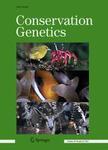版权所有:内蒙古大学图书馆 技术提供:维普资讯• 智图
内蒙古自治区呼和浩特市赛罕区大学西街235号 邮编: 010021

作者机构:South Dakota State Univ Dept Nat Resource Management SNP138Box 2140B Brookings SD 57007 USA Univ Wisconsin Coll Nat Resources 800 Reserve St Stevens Point WI 54481 USA Univ New Mexico Dept Biol MSC03-2020 Albuquerque NM 87131 USA Univ New Mexico Museum Southwestern Biol MSC03-2020 Albuquerque NM 87131 USA
出 版 物:《CONSERVATION GENETICS》 (资源保护遗传学)
年 卷 期:2016年第17卷第4期
页 面:775-784页
核心收录:
学科分类:0710[理学-生物学] 07[理学] 09[农学] 071007[理学-遗传学] 0901[农学-作物学] 090102[农学-作物遗传育种] 0713[理学-生态学]
基 金:South Dakota Department of Game, Fish and Parks through State Wildlife Grant [T2-2-R] South Dakota Agricultural Experiment Station through Hatch Award [H300-09] NIH [P20GM103542]
主 题:Genetic drift Genetic effective size Fragmentation Fish Streams Microsatellite Catostomidae
摘 要:A peripheral population of mountain sucker, Pantosteus jordani, located in the Black Hills of South Dakota, USA, represents the eastern-most range of the species and is completely isolated from other populations. Over the last 50 years, mountain sucker populations have declined in the Black Hills, and now only occur in 40 % of the historic local range, with densities decreasing by more than 84 %.We used microsatellite DNA markers to estimate genetic diversity and to assess population structure across five streams where mountain suckers persist. We evaluated results in the context of recent ecological surveys to inform decisions about mountain sucker conservation. Significant allele frequency differences existed among sample streams (Global F-ST = 0.041) but there was no evidence of isolation by distance. Regionally, genetic effective size, N-e, was estimated to be at least 338 breeding individuals, but N-e within streams was expected to be less. Despite almost complete demographic isolation and reduced population size, there appears to be little evidence of inbreeding, but genetic drift and local isolation due to fragmentation probably best explains genetic structure in this peripheral mountain sucker population. Recommended strategies for population enhancement include restoration of stream connectivity and habitat improvement. Moreover, repatriation and assisted movement (i.e., gene flow) of fishes should maximize genetic diversity in stream fragments in the Black Hills region.